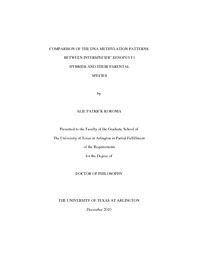
ATTENTION: The works hosted here are being migrated to a new repository that will consolidate resources, improve discoverability, and better show UTA's research impact on the global community. We will update authors as the migration progresses. Please see MavMatrix for more information.
Show simple item record
| dc.contributor.author | Koroma, Alie Patrick | en_US |
| dc.date.accessioned | 2011-07-14T20:54:21Z | |
| dc.date.available | 2011-07-14T20:54:21Z | |
| dc.date.issued | 2011-07-14 | |
| dc.date.submitted | January 2010 | en_US |
| dc.identifier.other | DISS-10999 | en_US |
| dc.identifier.uri | http://hdl.handle.net/10106/5866 | |
| dc.description.abstract | In this study the main focus is to compare the methylation patterns of interspecific Xenopus F1 hybrids to the parental species using Methyl-Sensitive Amplification Polymorphisms (MSAPs). Genomic DNA was extracted from the liver and muscle tissues from a representative sample of F1 hybrids and the parental species (Xenopus laevis and X. muelleri). First, the MSAP markers were very effective in comparing the methylation patterns of hybrids and the parental species. Genetic analysis of 504 liver and 364 muscle MSAP markers revealed that these markers were highly polymorphic. Principal coordinate analysis showed four distinct clusters with the two parental species separate and the F1s in between with respect to levels and patterns of methylation. Most of the variance among clusters can be explained by within cluster (population) variation. There was more variation in the liver tissues. Furthermore, Nei's genetic distances revealed more dissimilarity between the clusters with the muscle tissues compared to liver. Also, despite the fact that at least 50% of the MSAP markers in the F1 hybrids are derived from the parental species, there is some loss that is biased to both parental markers (i.e. most of the parental fragments not detected in the F1 hybrids come from either the paternal or maternal species depending on the sex of the F1). Fisher's exact test indicates the proportion of the loss of diagnostic parental fragments in the F1 is significant for the muscle tissue. The hybrids also exhibited unique MSAP markers. The average fraction of methylated MSAP fragments generated in this study ranges from 70.1% to 78.8% (75.0 ± 4; mean± SD) and 67.0% to 73.8% (69.1 ± 3.2; mean± SD) for liver and muscle tissues respectively. Furthermore genome sizes of F1 hybrids were intermediate between those of the parents. Finally undermethylation was observed in liver tissues of male F1 hybrid. | en_US |
| dc.description.sponsorship | Chippindale, Paul | en_US |
| dc.language.iso | en | en_US |
| dc.publisher | Biology | en_US |
| dc.title | Comparison Of The DNA Methylation Patterns Between Interspecific Xenopus F1 Hybrids And Their Parental Species | en_US |
| dc.type | Ph.D. | en_US |
| dc.contributor.committeeChair | Chippindale, Paul | en_US |
| dc.degree.department | Biology | en_US |
| dc.degree.discipline | Biology | en_US |
| dc.degree.grantor | University of Texas at Arlington | en_US |
| dc.degree.level | doctoral | en_US |
| dc.degree.name | Ph.D. | en_US |
Files in this item
- Name:
- KOROMA_uta_2502D_10999.pdf
- Size:
- 1.252Mb
- Format:
- PDF
This item appears in the following Collection(s)
Show simple item record


